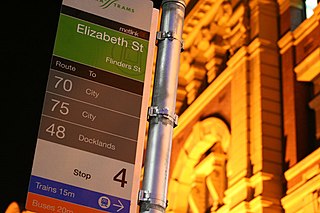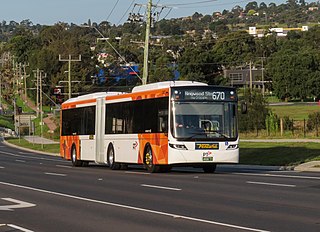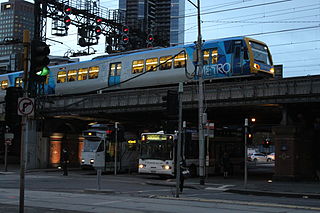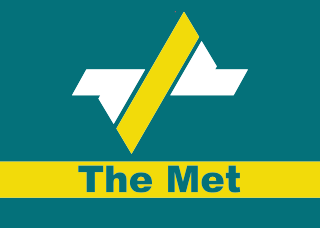The Transport Act 1983 (the Act) was the main statute establishing government transport organisations and regulating land transport activities in the State of Victoria, Australia for 27 years from mid-1983 to mid-2010. The Act was used as the vehicle for changes to transport organisational arrangements and transport regulation activities pursued by Victorian governments over that period.
The Transport Act received the royal assent on 23 June 1983 and commenced on 1 July of that year. [1] The Act remained as Victoria's principal transport statute until mid-2010 when that position was taken by a new statute, the Transport Integration Act 2010. It was renamed as the Transport (Compliance and Miscellaneous) Act 1983, a title which it retains to this day.
The Transport Act was initially passed by the Victorian Parliament as a major reform measure particularly in relation to institutional arrangements in the transport portfolio. The Act abolished a range of long-established transport agencies including the Victorian Railways, the Melbourne and Metropolitan Tramways Board and the Country Roads Board. [2] In their place a range of new organisations including the State Transport Authority, the Metropolitan Transit Authority, the Road Construction Authority and the Road Traffic Authority were established. [3] The Transport Act also established the Ministry of Transport as the prime coordinating agency for transport in Victoria.
The Transport Act also consolidated much of the suite of Victorian land transport statutes containing regulatory controls. The Act initially contained a suite of provisions affecting trains and trams, buses, taxis and hire cars and tow trucks. Few of these provisions remain today in the Transport (Compliance and Miscellaneous) Act. The main schemes which remain relate to taxi and hire car regulation, the only substantial area of Victorian transport regulation not to be contained in a discrete statute, and provisions relating to compliance and enforcement in safety areas and affecting public transport ticketing and conduct.
The major organisational changes brought about by the Transport Act were themselves the subject of major changes in the period after 1983.
In 1989, the Victorian Parliament passed a new statute, the Transport (Amendment) Act, which made major adjustments to the initial organisational changes made by the Transport Act in 1983. The new Act merged the State Transport Authority and the Metropolitan Transit Authority to establish a new organisation, the Public Transport Corporation, to manage train, tram and bus operations in metropolitan and regional areas of Victoria. The Transport (Amendment) Act also merged the Road Construction Authority and the Road Traffic Authority to create the Roads Corporation or VicRoads to manage the State's road network and its vehicle licensing and registration systems. The mergers took effect on 1 July 1989.
Other major organisational changes occurred after 1989 including the establishment of the office of the Director of Public Transport and the abolition of the Public Transport Corporation as well as the creation of discrete and special purpose organisations such as VicTrack and V/Line.
Many of the regulatory consolidations effected by the Transport Act have been reversed since the Act was initially passed. In many cases, the Victorian Parliament has acted to pass new principal statutes for subject matters previously regulated by the Transport Act, for example:
In early 2010, the Victorian Parliament passed a major new transport statute, the Transport Integration Act, which came into force on 1 July of that year. The new act superseded the Transport Act as Victoria's main transport statute and, at the same time, it extended the ambit of the legislation beyond land transport activities to cover ports and marine services. [4]
All Victorian transport organisations created by statute have been transferred to the Transport Integration Act including the land transport agencies previously established and empowered by the Transport Act. [4]
The Transport Integration Act changed the name of the Transport Act 1983 to the Transport (Compliance and Miscellaneous) Act 1983. [5] The name change took effect on 1 July 2010.

Metlink was the marketing body and umbrella brand for public train, tram and bus transport operators in Melbourne, Australia. On 2 April 2012, the operations of Metlink were transferred to the newly created public transport planning and management authority, Public Transport Victoria.

Buses in Melbourne, Australia, are a major form of public transport in Melbourne, with an extensive bus network. There are 346 routes in operation with a varying range of service frequencies, operated by privately owned bus companies under franchise from the State Government. The Night Network bus system consists of 10 routes and operates on Friday and Saturday nights, and a SmartBus orbital bus network currently consisting of nine routes, which is intended to facilitate cross city travel, while the current network is predominantly a radial network. Most of the bus network is a covered by the myki ticketing system.

Transport in Melbourne, the state capital of Victoria, Australia, consists of several interlinking modes. Melbourne is a hub for intercity, intracity and regional travel. Road-based transport accounts for most trips across many parts of the city, facilitated by Australia's largest freeway network. Public transport, including the world's largest tram network, trains and buses, also forms a key part of the transport system. Other dominant modes include walking, cycling and commercial-passenger vehicle services such as taxis.
VicRoads is a government joint venture in the state of Victoria, Australia. In the state, it is responsible for driver licensing and vehicle registration. It is owned and operated through a joint venture between the Victorian government and a consortium made up of Aware Super, Australian Retirement Trust and Macquarie Asset Management.

The Public Transport Corporation (PTC) was a Victoria State Government owned statutory authority formed under the Transport Act 1983 which operated passenger and freight trains, trams and bus services.
Transport law is the area of law dealing with transport. The laws can apply very broadly at a transport system level or more narrowly to transport things or activities within that system such as vehicles, things and behaviours. Transport law is generally found in two main areas:

The Transport Integration Act 2010 is a law enacted by the Parliament of the State of Victoria, Australia. The Act is the prime transport statute in Victoria, having replaced major parts of the Transport Act 1983, which was renamed as the Transport Act 1983.

The Transport Legislation Review is a policy and legislation review project conducted by the Department of Transport in the State of Victoria, Australia between 2004 and late 2010. The aim of the project was review of transport policy and laws and generation of new policy and legislation as a platform for better transport across the State.

The Department of Transport (DOT) was the government agency responsible for the coordination, integration and regulation of the transport system in the State of Victoria, Australia. The department generated planning, policy, and legislation for transport in Victoria. As a result, the department drove the integration of Victoria's transport land and water transport systems and the delivery of public transport, road and port services and associated activities across the State. The department's stated mission was "Building a safer, fairer and greener transport system for all Victorians to create a more prosperous and connected community."

The Rail Safety Act 2006 is a law enacted by the Parliament of the State of Victoria, Australia, and is the prime statute regulating the safety of rail operations in Victoria. The Act was developed as part of the Transport Legislation Review conducted by the Department of Transport between 2004 and 2010 and is aimed at preventing deaths and injuries arising from rail operations.

The Director of Public Transport was the head of the Public Transport Division (PTD) of the Victorian Department of Transport. PTD was the government agency responsible for promoting, providing, coordinating and regulating public transport in the state of Victoria, Australia between August 1999 and June 2013. The Director of Public Transport was created as a statutory office supported by staff of the Department of Transport.

The Tourist and Heritage Railways Act 2010 is a law enacted by the Parliament of the State of Victoria, Australia and is the prime statute regulating the activities of tourist and heritage rail operators in the State. The Act covers the bulk of Victoria's operational tourist and heritage railways including many heavy and light rail operations and tramways, predominantly in regional areas of Victoria.
The Director, Transport Safety, who operates as Transport Safety Victoria, is the independent Government agency responsible for bus and marine safety in the State of Victoria, Australia. The position was created as a statutory office by the Transport Integration Act 2010 and the office commenced operation on 1 July 2010. The Rail branch of TSV completed transfer to the Office of the National Rail Safety Regulator (ONRSR) in December 2019.
The Director, Public Transport Safety was the independent Government agency responsible for rail and bus safety in the State of Victoria, Australia, between 1 August 2006 and 30 June 2010. The position was created as a statutory office by statute in early 2006 and was the State's first independent public transport safety position. The office was superseded by the position of the Director, Transport Safety which commenced operation on 1 July 2010. The former Safety Director, Public Transport Safety, Alan Osborne, was directly appointed to the new office.
The Chief Investigator, Transport Safety is the independent Government agency responsible for investigation of safety-related trends and incidents in the rail, bus and marine industries in the State of Victoria, Australia.
Public Transport Victoria (PTV) is the brand name for public transport in the Australian state of Victoria. It was the trading name of the Public Transport Development Authority (PTDA), a now-defunct statutory authority in Victoria, responsible for providing, coordinating, and promoting public transport.

The Bus Safety Act 2009 is a law enacted by the Parliament of the State of Victoria, Australia and is the prime statute regulating the safety of bus operations in Victoria. The Act was developed as part of the Transport Legislation Review conducted by the Department of Transport between 2004 and 2010 and is aimed at preventing deaths and injuries arising from bus operations in Victoria and establishes a modern "best practice" regulatory framework to assist in maintaining and improving the Victorian bus industry's good safety record.

Commercial Passenger Vehicles Victoria (CPVV), until 2 June 2018 called the Taxi Services Commission (TSC), is the Government agency responsible for the regulation of the taxi and hire car industries in the State of Victoria, Australia. Before becoming a regulator, the TSC was responsible for conducting a major independent inquiry, the Taxi Industry Inquiry, into taxi and other small commercial passenger vehicle services in the State.
The Transport Legislation Amendment Act 2011 is a law enacted by the Parliament of the State of Victoria, Australia to reform taxi and other small commercial passenger vehicle services in the State.

The Transport Act 1983 is a prime statute regulating transport activities in the State of Victoria, Australia. Key areas regulated by the statute currently include taxi and hire car services and compliance and enforcement, particularly in areas like safety and public transport ticketing and conduct.